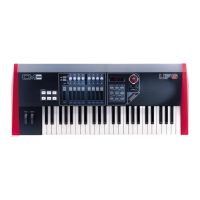
Do you have a question about the CME UF5 and is the answer not in the manual?
| Brand | CME |
|---|---|
| Model | UF5 |
| Category | Electronic Keyboard |
| Language | English |
Essential safety guidelines to prevent injury or damage from electrical hazards and improper use.
Important advisories regarding electrical safety, environmental hazards, and proper usage conditions.
Overview and explanation of buttons, knobs, and faders on the keyboard's front interface.
Identification and function of all input/output terminals located on the rear of the keyboard.
Instructions for linking the UF keyboard to external sound modules or synthesizers.
Steps for integrating the UF keyboard into a computer-based music production setup.
Procedure for installing necessary software drivers for computer connectivity.
Procedure for powering up the instrument and ensuring proper connections before operation.
Instructions on how to activate and listen to the built-in demonstration song.
How to restore the keyboard's settings to their original factory default state.
Methods for adjusting parameter values using the data dial and increment/decrement buttons.
Guide to choosing and changing the sounds or 'voices' for the keyboard.
Using the pitch bend and modulation wheels to add expression to performances.
Operating faders for volume control and understanding their customizable functions.
Adjusting the keyboard's pitch by semitones (Transpose) or octaves (Octave Shift).
How to use the 'All Notes Off' command to stop all currently sounding notes.
Setting and changing the MIDI channel for transmitting messages to other devices.
Using and assigning functions to the eight assignable knobs for parameter editing.
Sending system exclusive messages for GM, XG, and GS initialization.
Configuring the keyboard's touch sensitivity response through different velocity curves.
Dividing the keyboard into two sections with independent voice and channel settings.
Layering two different voices to play simultaneously for richer sounds.
Enabling or disabling the after touch feature for expressive note manipulation.
Utilizing faders as drawbars for authentic organ sound control.
Using front panel buttons to control DAW playback, recording, and transport functions.
Configuring the routing of MIDI data between the keyboard, computer, and other devices.
A comprehensive table detailing MIDI controller numbers and their functions.
Solutions for common issues encountered during keyboard operation and connectivity.
Detailed information on keyboard models, functions, controls, and connectivity.
Overview of the keyboard's MIDI message transmission and reception capabilities.
An alphabetical listing of manual topics with corresponding chapter references.
